Index by author
Sakai, O.
- FELLOWS' JOURNAL CLUBHead and Neck ImagingYou have accessCT Texture Analysis Potentially Predicts Local Failure in Head and Neck Squamous Cell Carcinoma Treated with ChemoradiotherapyH. Kuno, M.M. Qureshi, M.N. Chapman, B. Li, V.C. Andreu-Arasa, K. Onoue, M.T. Truong and O. SakaiAmerican Journal of Neuroradiology December 2017, 38 (12) 2334-2340; DOI: https://doi.org/10.3174/ajnr.A5407
This was a retrospective study including 62 patients diagnosed with primary head and neck squamous cellcarcinoma who underwent contrast-enhanced CT examinations for staging, followed by chemoradiotherapy. CT texture features of thewhole primary tumor were measured using an in-house developed Matlab-based texture analysis program. Histogram, gray-level co-occurrence matrix, gray-level run-length, gray-level gradient matrix, and Laws features were used for texture feature extraction. Three histogram features (geometric mean, harmonic, and fourth moment) and 4 gray-level run-length features (short-run emphasis, gray-level nonuniformity, run-length nonuniformity, and short-run low gray-level emphasis) were significant predictors of outcome.
Sasaki, M.
- EDITOR'S CHOICEExtracranial VascularOpen AccessPreoperative Cerebral Oxygen Extraction Fraction Imaging Generated from 7T MR Quantitative Susceptibility Mapping Predicts Development of Cerebral Hyperperfusion following Carotid EndarterectomyJ.-i. Nomura, I. Uwano, M. Sasaki, K. Kudo, F. Yamashita, K. Ito, S. Fujiwara, M. Kobayashi and K. OgasawaraAmerican Journal of Neuroradiology December 2017, 38 (12) 2327-2333; DOI: https://doi.org/10.3174/ajnr.A5390
Seventy-seven patients with unilateral internal carotid artery stenosis underwent preoperative 3DT2*-weighted imaging using a multiple dipole-inversion algorithm with a 7T MR scanner. Quantitative susceptibility mapping images wereobtained, and oxygen extraction fraction maps were generated. Quantitative brain perfusion single-photon emission CT was alsoperformed before and immediately after carotid endarterectomy. Ten patients (13%) showed post–carotid endarterectomy hyperperfusion. Multivariate analysis showed that a high quantitative susceptibility mapping–oxygen extraction fraction ratio was significantly associated with the development of post–carotid endarterectomy hyperperfusion.
Saver, J.L.
- NeurointerventionYou have accessCorrelation between Clinical Outcomes and Baseline CT and CT Angiographic Findings in the SWIFT PRIME TrialA.P. Jadhav, H.-C. Diener, A. Bonafe, V.M. Pereira, E.I. Levy, B.W. Baxter, T.G. Jovin, R.G. Nogueira, D.R. Yavagal, C. Cognard, D.D. Purcell, B.K. Menon, R. Jahan, J.L. Saver and M. Goyal on behalf of the SWIFT PRIME investigatorsAmerican Journal of Neuroradiology December 2017, 38 (12) 2270-2276; DOI: https://doi.org/10.3174/ajnr.A5406
Serai, S.
- Pediatric NeuroimagingYou have accessQuantitative Synthetic MRI in Children: Normative Intracranial Tissue Segmentation Values during DevelopmentA. McAllister, J. Leach, H. West, B. Jones, B. Zhang and S. SeraiAmerican Journal of Neuroradiology December 2017, 38 (12) 2364-2372; DOI: https://doi.org/10.3174/ajnr.A5398
Shah, M.
- LetterYou have accessReply:P.C. Reinacher, M.T. Krüger, V.A. Coenen, M. Shah, R. Roelz, C. Jenkner and K. EggerAmerican Journal of Neuroradiology December 2017, 38 (12) E106-E108; DOI: https://doi.org/10.3174/ajnr.A5386
Shallwani, H.
- EDITOR'S CHOICENeurointerventionYou have accessPredictors of Incomplete Occlusion following Pipeline Embolization of Intracranial Aneurysms: Is It Less Effective in Older Patients?N. Adeeb, J.M. Moore, M. Wirtz, C.J. Griessenauer, P.M. Foreman, H. Shallwani, R. Gupta, A.A. Dmytriw, R. Motiei-Langroudi, A. Alturki, M.R. Harrigan, A.H. Siddiqui, E.I. Levy, A.J. Thomas and C.S. OgilvyAmerican Journal of Neuroradiology December 2017, 38 (12) 2295-2300; DOI: https://doi.org/10.3174/ajnr.A5375
This was a retrospective analysis of 465 consecutive aneurysms treated with the Pipeline Embolization Device between 2009 and 2016, at 3 academic institutions in the United States. Cases with angiographic follow-up were selected to evaluate factors predictive of incomplete aneurysm occlusion at last follow-up. Older age (more than 70 years), nonsmoking status, aneurysm location within the posterior communicating artery or posterior circulation, greater aneurysm maximal diameter (>21 mm), and shorter follow-up time (<12 months) were significantly associated with incomplete aneurysm occlusion at last angiographic follow-up.
Shimoyama, S.
- Spine Imaging and Spine Image-Guided InterventionsYou have accessAdvantages of 70-kV CT Angiography for the Visualization of the Adamkiewicz Artery: Comparison with 120-kV ImagingS. Shimoyama, T. Nishii, Y. Watanabe, A.K. Kono, K. Kagawa, S. Takahashi and K. SugimuraAmerican Journal of Neuroradiology December 2017, 38 (12) 2399-2405; DOI: https://doi.org/10.3174/ajnr.A5372
Shin, D.H.
- LetterYou have accessRegarding “Perfusion MR Imaging Using a 3D Pulsed Continuous Arterial Spin-Labeling Method for Acute Cerebral Infarction Classified as Branch Atheromatous Disease Involving the Lenticulostriate Artery Territory”D.H. Shin and E.Y. KimAmerican Journal of Neuroradiology December 2017, 38 (12) E103; DOI: https://doi.org/10.3174/ajnr.A5356
Shin, S.Y.
- Head and Neck ImagingYou have accessEfficacy and Safety of Ethanol Ablation for Branchial Cleft CystsE.J. Ha, S.M. Baek, J.H. Baek, S.Y. Shin, M. Han and C.-H. KimAmerican Journal of Neuroradiology December 2017, 38 (12) 2351-2356; DOI: https://doi.org/10.3174/ajnr.A5373
Shinohara, Y.
- LetterYou have accessReply:Y. Shinohara and T. OgawaAmerican Journal of Neuroradiology December 2017, 38 (12) E104; DOI: https://doi.org/10.3174/ajnr.A5364








